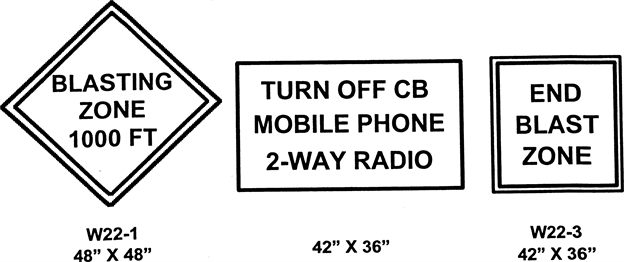Precautions must be taken to prevent unintended electric detonator discharge from extraneous electricity and radio frequency (RF) transmitters. The following are sources of common hazards for extraneous electricity and RF transmissions:
(1) Extraneous electricity. Common hazardous sources of extraneous electricity include:
(a) Adjacent power lines;
(b) Dust storms;
(c) Lightning storms.
(2) RF transmission sources. Common hazardous sources of RF transmissions include:
(a) Mobile transmitters:
(i) Citizen band (CB);
(ii) Side band radio;
(iii) VHF (FM) radio;
(iv) UHF cellular telephones;
(v) Radar.
(b) Fixed location transmitters:
(i) Base stations for CB;
(ii) Side band or FM radio communications;
(iii) UHF cellular telephone transmitters and service extension repeater systems;
(iv) AM and FM (commercial) radio broadcast transmitters;
(v) TV broadcast transmitters and repeater system transmitters;
(vi) Surface scan and radio navigation beacons.
(c) Low flying aircraft (in particular military aircraft) create the most common serious RF exposures. These highly unpredictable mobile transmitters are very powerful and transmit on a broad spectrum of frequencies, which include, but are not limited to:
(i) Radar;
(ii) Laser;
(iii) All common communications bands.
Note: | The two most dangerous examples are: |
– Low flying automatic terrain following guidance systems | |
– Airplanes which are equipped to jam all common radar and communications frequencies for a distance of several miles around the airborne transmitters. |
(3) Transportation. Transportation of explosives must meet these requirements:
(a) Public highways. The Washington utilities and transportation commission (UTC) and Washington state department of transportation (WSDOT) require compliance with ANSI D6.1-1988, Uniform Traffic Control Devices;
(b) Private roads. You do not have to comply with ANSI on private roads under department jurisdiction if required warning signs are properly placed when electric detonators are present.
(4) Site survey. The blaster in charge must conduct or assign a designated appointee to conduct an accurate survey of the entire blast area, to determine:
(a) The clearance points where roads or right of ways enter and exit the required clearance zone;
(b) If the one thousand-foot clearance zone needs adjusting to maintain the permissible clearance zone at all times, if the blast area moves as the job progresses.
(5) Clearance zones.
Required clearance zones for: | Number of feet |
Construction operations | 1000 feet |
Demolition operations | 1000 feet |
General industry operations, not subject to construction requirements | 350 feet |
(6) RF-transmitter warning signs.
RF-TRANSMITTER WARNING SIGNS
 |
(a) RF-transmitter warning-sign specifications.
Signs must:
(i) Be a specific size. See the signs above for sign dimensions;
(ii) Have a "construction" orange background;
(iii) Have black letters and borders;
(iv) Use all upper case letters that are at least the size shown above.
Note: | Larger signs may be required where the highway speed limit is more than fifty-five miles per hour. |
(b) Posting warning signs must:
(i) Be adequately placed to warn:
(A) All transmitter users against the use of:
(I) Radio frequency transmitters;
(II) CBs;
(III) Mobile phones;
(IV) Two-way radios.
(B) All users of routes into the electric detonator clearance zone.
(ii) Be prominently displayed when an electric detonator initiation system is being used during blasting operations and when the electric detonators have been removed from the original U.S. DOT approved shipping container;
(iii) Be posted at the beginning of the blast zone minimum clearance point saying:
"TURN OFF CB, MOBILE PHONE, 2-WAY RADIO"
(c) Blast zone signs.
(i) The "BLAST ZONE 1,000 FEET" sign must be posted one thousand feet before the "TURN OFF CB, MOBILE PHONE, 2-WAY RADIO" sign;
(ii) The one thousand-foot separation distance limit may be reduced (not less than three hundred feet) in very slow vehicle travel zones (such as off-road construction right of ways, rock pits, or quarries).
(d) An "END BLAST ZONE" sign must be posted outside the blasting zone clearance limits.
(e) Signs must be covered or removed when blasting operations are not being conducted.
(7) Voltage identification. Electrical transmission and distribution line voltage must be accurately identified.
(8) System clearance identification. The required clearance for each system must be accurately identified.
(9) RF transmitters. Mobile RF transmitters must be deenergized or disconnected when they are less than one hundred feet from electric detonators that are not fully contained in their original U.S. DOT shipping containers.
Note: | Fixed location RF transmitters represent a higher level of hazard to both storage and blasting operations involving electric detonators because the transmitters are more powerful and transmit dangerous levels of RF exposure over much greater distances. |
(10) Prevention of radio frequency hazards:
(a) Electric detonators in storage or at blasting operations must meet the appropriate distance table requirements published in the IME Publication Number 20, 1988, "Safety Guide for the Prevention of Radio Frequency Hazards in the Use of Commercial Electric Detonators (Blasting Caps)."
(b) If it is necessary to conduct blasting operations inside the required separation distances specified in the IME Pamphlet Number 20, 1988:
(i) Storage and use of electric detonators is prohibited on the site;
(ii) Only detonating cord, safety fuse, shock tube, or other approved nonelectric systems can be used.